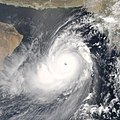|
تضامنًا مع حق الشعب الفلسطيني |
ملف:Gonu 04 jun 2007 0900Z.jpg
اذهب إلى التنقل
اذهب إلى البحث

حجم هذه المعاينة: 600 × 600 بكسل. الأبعاد الأخرى: 240 × 240 بكسل | 480 × 480 بكسل | 768 × 768 بكسل | 1٬024 × 1٬024 بكسل | 2٬048 × 2٬048 بكسل | 5٬400 × 5٬400 بكسل.
الملف الأصلي (5٬400 × 5٬400 بكسل حجم الملف: 3٫66 ميجابايت، نوع MIME: image/jpeg)
تاريخ الملف
اضغط على زمن/تاريخ لرؤية الملف كما بدا في هذا الزمن.
| زمن/تاريخ | صورة مصغرة | الأبعاد | مستخدم | تعليق | |
|---|---|---|---|---|---|
| حالي | 00:49، 5 يونيو 2007 |  | 5٬400 × 5٬400 (3٫66 ميجابايت) | commonswiki>Good kitty | == Summary == {{Information |Description=You might expect to see a storm with near-perfect symmetry and a well-defined eye hoovering over the warm waters of the Caribbean or in the South Pacific, but Tropical Cyclone Gonu showed up in an unusual place. On |
استخدام الملف
ال1 ملف التالي مكررات لهذا الملف (المزيد من التفاصيل):
- ملف:Gonu 04 jun 2007 0900Z.jpg من ويكيميديا كومنز
الصفحة التالية تستخدم هذا الملف:

